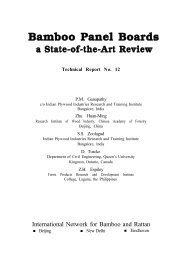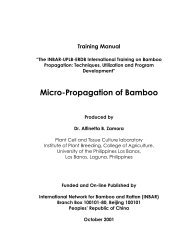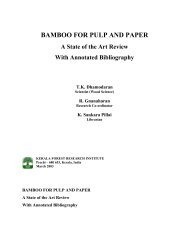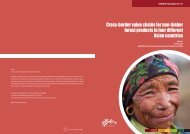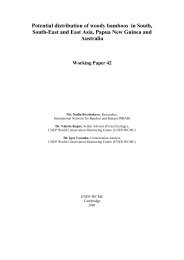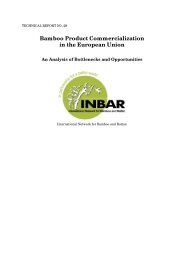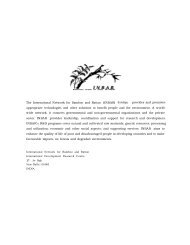The Bamboo and Rattan Sectors in Asia: an Analysis of ... - INBAR
The Bamboo and Rattan Sectors in Asia: an Analysis of ... - INBAR
The Bamboo and Rattan Sectors in Asia: an Analysis of ... - INBAR
You also want an ePaper? Increase the reach of your titles
YUMPU automatically turns print PDFs into web optimized ePapers that Google loves.
that would be useful <strong><strong>an</strong>d</strong> applicable across several regions <strong><strong>an</strong>d</strong> countries (that is,<br />
the research should have "regional relev<strong>an</strong>ce"). Strategically, the socio-economic<br />
research needed to take a holistic approach, consider<strong>in</strong>g the technical issues alongside<br />
the social <strong><strong>an</strong>d</strong> economical issues. Moreover, <strong><strong>an</strong>d</strong> perhaps most import<strong>an</strong>tly, the<br />
research needed to be pragmatic <strong>in</strong> its approach, to lead to practical results <strong><strong>an</strong>d</strong><br />
recommendations.<br />
<strong>INBAR</strong>'s Socio-Economics Work<strong>in</strong>g Group (SEWG) proposed two pr<strong>in</strong>cipal thrusts<br />
for the Socio-economic Research Program work that could be accomplished <strong>in</strong>itially.<br />
First, five "<strong>Bamboo</strong> <strong><strong>an</strong>d</strong> <strong>Ratt<strong>an</strong></strong> Database Studies" for collat<strong>in</strong>g exist<strong>in</strong>g qu<strong>an</strong>titative<br />
socio-economic data <strong>in</strong> key countries, <strong>in</strong>clud<strong>in</strong>g production <strong><strong>an</strong>d</strong> trade statistics, were<br />
done. <strong>The</strong>se were small studies <strong>in</strong>tended primarily to review secondary literature,<br />
<strong>in</strong>clud<strong>in</strong>g the grey literature, <strong><strong>an</strong>d</strong> collate <strong>in</strong>formation available from different sources<br />
<strong>in</strong>to a rational system for further work. <strong>The</strong>se studies found m<strong>an</strong>y <strong>in</strong>consistencies <strong>in</strong><br />
the available data <strong>in</strong> terms <strong>of</strong> def<strong>in</strong>itions <strong>of</strong> categories <strong><strong>an</strong>d</strong> units <strong>of</strong> measurement.<br />
<strong>The</strong>y also brought to light a lack <strong>of</strong> st<strong><strong>an</strong>d</strong>ard grad<strong>in</strong>g <strong><strong>an</strong>d</strong> classification systems for<br />
bamboo <strong><strong>an</strong>d</strong> ratt<strong>an</strong> raw materials <strong><strong>an</strong>d</strong> products, <strong>in</strong>complete <strong><strong>an</strong>d</strong> out-<strong>of</strong>-date <strong>in</strong>ventory<br />
data, large gaps <strong>in</strong> time series <strong><strong>an</strong>d</strong> lack <strong>of</strong> data on the people <strong>in</strong>volved <strong>in</strong> the sector.<br />
<strong>The</strong>se weaknesses were compounded by the widely prevalent under-report<strong>in</strong>g <strong>of</strong><br />
production <strong><strong>an</strong>d</strong> consumption data, especially regard<strong>in</strong>g the large volume <strong>of</strong> material<br />
traded <strong>in</strong> <strong>in</strong>formal markets.<br />
<strong>The</strong> second thrust proposed for the Socio-economic Research Program was a<br />
series <strong>of</strong> studies by national program researchers. <strong>The</strong> studies were designed to satisfy<br />
two pr<strong>in</strong>cipal objectives: (1) to identify constra<strong>in</strong>ts <strong><strong>an</strong>d</strong> opportunities for susta<strong>in</strong>able<br />
development with<strong>in</strong> particular bamboo <strong><strong>an</strong>d</strong> ratt<strong>an</strong> production-to-consumption systems,<br />
<strong><strong>an</strong>d</strong> to recommend appropriate <strong>in</strong>terventions; <strong><strong>an</strong>d</strong> (2) to provide a basis for elicit<strong>in</strong>g<br />
more general lessons applicable to the bamboo <strong><strong>an</strong>d</strong> ratt<strong>an</strong> sectors <strong>in</strong> particular <strong><strong>an</strong>d</strong> to<br />
NTFPs <strong>in</strong> general. A common conceptual framework was developed <strong><strong>an</strong>d</strong> used <strong>in</strong> all<br />
these studies. A systems approach was used, consider<strong>in</strong>g everyth<strong>in</strong>g from the<br />
production <strong>of</strong> the raw material through to the f<strong>in</strong>al market. Each tr<strong>an</strong>sformation<br />
po<strong>in</strong>t was studied with reference to the stakeholders <strong>in</strong>volved, the functions performed,<br />
<strong><strong>an</strong>d</strong> the vertical <strong><strong>an</strong>d</strong> horizontal market l<strong>in</strong>kages. <strong>The</strong> policy environment <strong><strong>an</strong>d</strong> other<br />
factors that <strong>in</strong>fluence stakeholder decision-mak<strong>in</strong>g were also considered where<br />
possible.<br />
This Production-to-Consumption Systems (PCS) approach also recognized that<br />
the <strong>in</strong>tensity <strong>of</strong> m<strong>an</strong>agement def<strong>in</strong>ed as capital <strong><strong>an</strong>d</strong> labor <strong>in</strong>puts per unit <strong>of</strong> l<strong><strong>an</strong>d</strong> is<br />
a critical factor <strong>in</strong> m<strong>an</strong>ag<strong>in</strong>g biological resources, especially those harvested from the<br />
"wild". Hence, <strong>in</strong>dividual studies were selected to represent a r<strong>an</strong>ge <strong>of</strong> <strong>in</strong>tensities <strong>of</strong><br />
raw material production <strong><strong>an</strong>d</strong> process<strong>in</strong>g.<br />
<strong>The</strong> PCS studies gave a clear <strong>in</strong>dication <strong>of</strong> the high import<strong>an</strong>ce <strong>of</strong> bamboo <strong><strong>an</strong>d</strong><br />
ratt<strong>an</strong> <strong>in</strong> terms <strong>of</strong> subsistence use, ecological <strong><strong>an</strong>d</strong> economic benefits as <strong>in</strong>tegral<br />
components <strong>of</strong> farm<strong>in</strong>g systems, <strong><strong>an</strong>d</strong> on-farm <strong><strong>an</strong>d</strong> <strong>of</strong>f-farm employment <strong><strong>an</strong>d</strong> <strong>in</strong>come<br />
generation. Some <strong>of</strong> the more developed systems demonstrated the high potential for<br />
2



